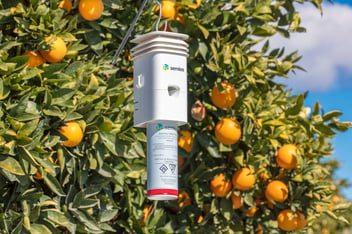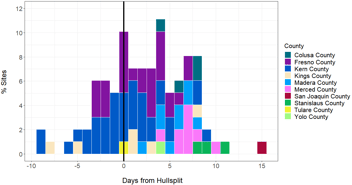Regional Codling Moth Emergence Patterns - Spring 2021
Management of codling moth begins in the spring soon after the emergence of adults from the overwintering generation. Shortly after emergence, these moths will begin to lay eggs, and when these eggs hatch the crop will be at risk. This event is marked by the first codling moth trap captures of the season, often called “biofix”.
To set the stage, here is a map depicting when the first codling moth trap captures occurred in 2021 across Washington (see Figure 1 below). This graph is measured in degree days from January 1st.
The first thing you will notice is that there is variation both within and between distinct growing regions throughout the state. Given that this important event starts the clock on codling moth management, let's explore the factors that influence first codling moth trap captures, and help explain why observations of first trap capture may vary from orchard to orchard and may diverge from predictions.
Figure 1: a map depicting when the first codling moth trap captures occurred in 2021 across Washington.
A number of factors influence when the first trap capture will occur, and understanding what these factors are and how they relate to each other may provide insights into the codling moth populations infesting your orchards.
Understanding Effects of Microclimate on Codling Moth Emergence Times
1. Temperature
The most important factor affecting first capture is temperature. Codling moths, like all insects, develop in a predictable way according to the temperature of their environment. In general, they develop faster when it’s warm than when it's cool. Insect development is measured in degree days, and is calculated from data collected by weather stations.
The accuracy of degree day accumulation will depend on your information source.
2. Location
But, it's not that quite that simple. The first moths you see in the spring spend the winter as larvae/pre-pupae somewhere in the vicinity of your orchard. There are a few different places they like to overwinter:
- They can be found on host trees in knots, burrs, cracks in bark, graft unions, or branch-points.
- In the leaf-litter or ground cover surrounding a host tree.
- Or, they can also be found in the corners of bins or other storage equipment, if they were on or in an apple at harvest.
This is important information to know because these overwintering locations may have different microclimates. What this means is that although the air temperature may be similar, the temperature at each of these overwintering sites will be a bit different, and if it's a little different each day it has the potential to add up.
This has been clearly demonstrated in the case of moths overwintering in bins. In this instance, moths have a delayed and prolonged emergence from bins, due to the insulating properties of large bin stacks.
Simply put, where your moths are overwintering in your orchard can influence when they emerge in the spring. If they were infesting a block at the cool end of the orchard, they will likely emerge later than if they were infesting a warm block.
3. Mating Disruption
Using mating disruption typically delays the first trap capture of the season. Keep in mind that mating disruption will interfere with a male moth's ability to find females, and its ability to find traps.
Most codling moth lures on the market today will attract both males and females, but if mating disruption prevents males from finding traps, traps will capture mostly females. Furthermore male codling moths are thought to emerge earlier than females.
Therefore, if you are using mating disruption, trap capture in the early spring may be suppressed, due to the fact that there are fewer moths to trap (the males have been disrupted), and the females may on average emerge a little later.
4. Population Density
The final factor that influences first trap capture is pest pressure. Sometimes, it's just a numbers game. When there is moderate or high pest pressure, trap captures are often earlier than under low pressure. This is largely due to the fact that the more moths that are around the more likely it is to trap one, and the more likely that any individual moth will reside within a warm microclimate.
How to account for and address variation?
What does this mean for you? Well for one it may explain why your observed codling moth trap captures are earlier or later than other growers in your region, or if your observations line up with expectations from previous years or industry expectations.
Given this potential variability, how do you plan ahead? The best answer for that is to look at your in-orchard data pertaining to codling moths. There is no substitute for good trapping data, and with Semios automatic camera traps it is easy to explore the spatial and temporal patterns in codling moth flight in your orchard.
Some final questions you may want to ask yourself,
- What degree days have I observed first captures in my orchards in previous years?
- Is this different across my orchard(s)?
- Or, is it uniform?
And remember, when in doubt the data collected from weather stations and traps in your orchards is the best source of information to guide future management.



